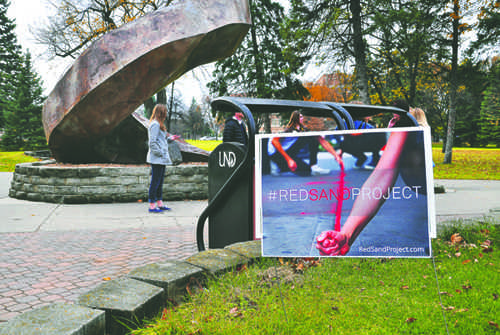Invisible slaves

The Red Sand Project, taking place Friday in front of the ‘Persistence’ statue on campus, aims to raise awareness about human trafficking and other forms of exploitation.
November 1, 2016
Historian and activist speaks to students, detailing the “Red Sand Project”
At noon on Friday, Oct. 28, people gathered near the Memorial Union for a moving installment of the Red Sand Project. The Red Sand Project is a way to spread awareness of slavery that goes on all around the world today.
“We place red sand in the cracks of public sidewalks to raise awareness about the millions of enslaved people who fall through the cracks every day,” Nikki Berg Burin, a historian and activist, said.
When people walk by and see the red sand in the cracks, Berg Burin hopes that people will stop and ask questions.
“One of the problems with modern day slavery,” Berg Burin said, “is that it’s invisible. We don’t see it and so we don’t have to think about it.”
With #RedSandProject chalked near the cracks, it makes it easy to find an answer.
The Red Sand Project was created by Molly Gochman, a New York artist, because of the 45 – 46 million slaves around the world, most of which are hidden. According to her website, she believes that no one should just pass by the most “marginalized populations in our communities.”
Berg Burin was also blown away by the number of slaves in today’s world.
“That’s more than at any time in human history,” she said.
Berg Burin has been researching African American slavery from before the Civil War era and more recently has begun her research on sex trafficking.
Basically, she combined her academic research to her activist personality. Also, she wanted to make it relatable to her current surroundings.
“When I moved back to North Dakota during the oil boom, it was very clear that sex trafficking was on the rise,” Berg Burin said.
This leads directly to what Berg Burin stresses immensely. Slavery only exists because of the high demand for commercial sex and products made by slave laborers.
“If there was no demand, traffickers would have no incentive to enslave people,” Berg Burin said.
Almost everyone contributes to the slave industry. Owning a slave is not the only way to contribute. All sorts of things, from cucumbers to fireworks, are produced by slave labor factories.
“We have a lot of power as consumers,” said Berg Burin. “We are still tied and connected to this huge problem.”
There’s a website called slaveryfootprint.org where you can find out how many slaves “work for you” based off of simple questions regarding your daily life.
Slave labor isn’t the only type of slave still out there today. Around 22 percent of all slaves are sex slaves according to the Global Slavery Index. Berg Burin reported that homeless youth are the most at risk for this type of slavery because of their vulnerability and lack of support from others.
But that’s not the only way people get sucked into the slavery world. Things such as natural disasters, extreme poverty, and police corruption can be factors as well.
“There’s a lot of different factors that go into it,” said Berg Burin.
The Red Sand Project is a participatory activist art project. It can be done at anytime and anywhere. If you were unable to attend the event last Friday, it is possible to go online and request a free sand kit. Going to mollygochman.com will have more information on how to get the kit and how to spread awareness.
Rachel Cox is a staff writer for The Dakota Student. She can be reached at rachel.a.cox@und.edu

